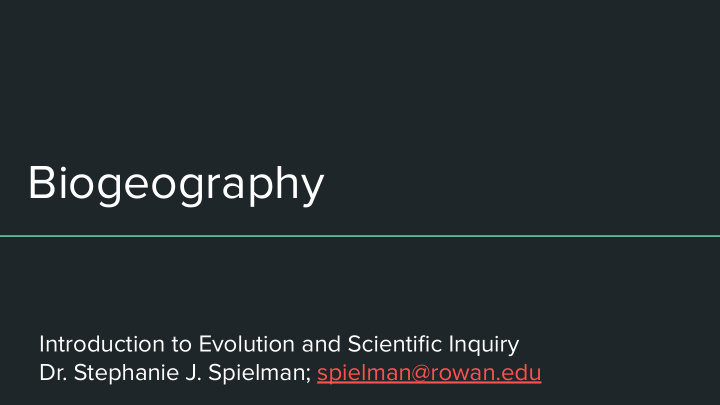



Biogeography Introduction to Evolution and Scientific Inquiry Dr. Stephanie J. Spielman; spielman@rowan.edu
Biogeography ● Biogeography is the study of the geographic distribution of species and the processes which give rise to these distributions E.g., this is..not right. ● studies the patterns of geographic distribution of organisms and the causes for these patterns.
Alfred Russell Wallace: "Father" of biogeography
Wallace's Line Observed distinct fauna (animal) distributions on different sides of this line. The earliest "biogeographic border"
A few biogeographical patterns Biodiversity hotspots in the tropics Islands tend to have fewer species
How do species get to live where they do? ● Vicariance : Changes in geography drive changes in species distributions The Earth moves you ○ ● Dispersal : A species extends its geographic range into a new area where it did not previously live You move somewhere else ○ ● One of two things will happen when a species ends up in a new geographic region. ○ It adapts to the new environment and survives ○ It fails to adapt to the new environment and goes extinct ○ Hence, we see many adaptations!
Convergent evolution in similar habitats is a signal of adaptation
Convergence often signals adaptation
Species history from phylogenies Each color is a distinct geographic area
Speciation, vicariance, and phylogenies Lines indicate new geographic barriers, and letters (x,y,z) represent species A geographic region Vicariance event leads to speciation Another vicariance event. How about speciation?
Hawaiian Drosophila species relationships match order of island origin ● Means that vicariance is a major determinant of species distributions
Geologic changes over time by continental drift https://www.youtube.com/watch?v=UwWWuttntio
A case study: Ratite Bird Biogeography Ratites are flightless birds . How do they have this geographical distribution? A flying relative**
One hypothesis: distribution by vicariance
If vicariance, the phylogeny would EXACTLY MATCH the geography changes Tinamous outgroup (South America) Rheas (South America) Emu + cassowary (Australia) Moa (New Zealand, extinct) Kiwi (New Zealand) Elephant Bird (Africa, extinct) Ostrich (Africa) 10.1126/science.1251981
The phylogeny made from DNA is very different - so dispersal contributed to speciation Moa (New Zealand, Tinamous outgroup extinct) (South America) Tinamous (South America) Rheas (South America) Elephant Bird (Africa, Emu + cassowary extinct) (Australia) Kiwi (New Zealand) Moa (New Zealand, extinct) Emu + Cassowary Kiwi (New Zealand) (Australia) Elephant Bird Rheas (South (Africa, extinct) America) Ostrich (Africa) Ostrich (Africa)
Fossil data reveals a Northern hemisphere (Laurasia) origin http://dx.doi.org/10.1016/j.cub.2016.12.023
Another overall view
Another example: snapping shrimp
Recommend
More recommend